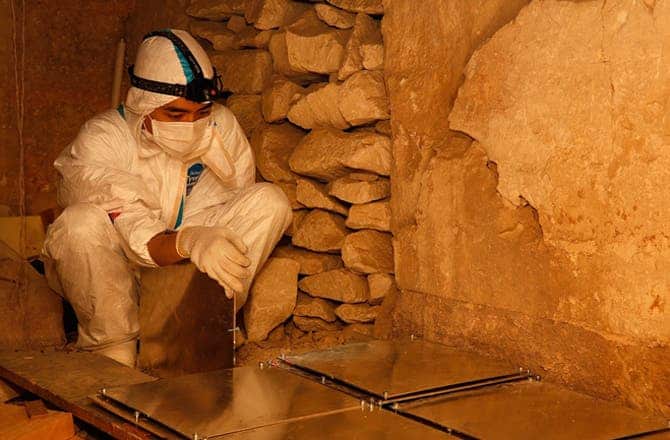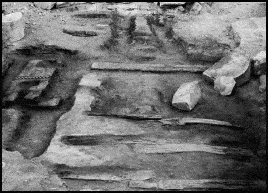The Great Pyramids of Giza were built on a rocky plateau on the west bank of the Nile River some 4500 years ago. The northernmost and oldest pyramid of the group was built for Khufu (Greek: Cheops), the second king of the 4th dynasty. Khufu’s Pyramid is the oldest and most impressive pyramid at the site. Some 2.3 million blocks of stone were used to erect this marvelous display of engineering and technical skill — a 5,750,000-ton mega structure. Once it was built, any man gazing it must have felt very humble. To this day — when we’ve managed to raise skyscrapers like the 829m tall Burj Khalifa — scientists are still debating how exactly the ancient Egyptians managed to built them. Using cutting edge technology, scientists are now surveying the Great Pyramids of Giza to unravel new clues and maybe find hidden chambers.

Anomalies in the pyramids
Called ScanPyramids, the project employs tools such as infrared thermography, muon radiography, and 3-D reconstruction to identify the presence of unknown internal structures and cavities. Researchers are working under the leadership of the Cairo University’s Faculty of Engineering and the Paris-based non-profit organization Heritage, Innovation and Preservation Institute (HIPI).
Already, the project has some interesting results to share. In November, a thermal anomaly was found on the eastern side of the Great Pyramid at Giza. Upon further inspection, a similar anomaly was found on the northern side. In other words, they found clear differences in temperatures in various sections of the pyramid, hot and cold zones. This suggests chambers or some other internal structures hidden from the naked eye. These are still preliminary findings, so the researchers need to survey these areas over a long time to make sure what they’re recording isn’t actually the wind warming or chilling the stone or some other environmental noise. “We are not drawing any conclusions at the moment,” Mehdi Tayoubi, co-director of the ScanPyramids mission with Hany Helal, professor at Cairo University’s Faculty of Engineering.
They’ll know more for sure once they install muon plans inside the Great Pyramid next month. Muons are made in the upper atmosphere when cosmic particles interact with atoms in the atmosphere. The muon is a fundamental particle that acts like a heavy electron, with a mass about 207 times that of an electron. What’s interesting about these particles is that they can pass through any structure, and just like X-rays can show your skeleton, so can a muon radiography reveal structures as the particles pass through voids or, conversely, get absorbed or deflected by matter.
X-raying the pyramids

Muon-detecting plates are placed within the Bent Pyramid. Rights: PHILIPPE BOURSEILLER FOR HIP.INSTITUTE, EGYPTIAN MINISTRY OF ANTIQUITIES, FACULTY OF ENGINEERING CAIRO UNIVERSITY
Such a survey was made on the Bent Pyramid, Dahshur, just outside Cairo — one of the Great Pyramids that distinguishes itself by the bent slope of its sides. Archaeologists think it’s ancient Egypt’s first attempt at engineering a smooth-sided pyramid. The 40 muon detector plates were collected and are reportedly in good condition. Researchers are still analyzing them.
Hany Helal, vice president of HIPI, said: “For the construction of the pyramids, there is no single theory that is 100 per cent proven or checked; they are all theories and hypotheses.
“What we are trying to do with the new technology, we would like to either confirm or change or upgrade or modify the hypotheses that we have on how the pyramids were constructed.”
Using this combination of techniques, researchers can peer through the structure and better understand how these were built. Right now, there’s no other way to know for sure apart from putting the pyramids apart stone by stone.
Based on archaeological finds, historical interpretations and what he know about the technology ancient Egyptians had at their disposal, there are a number of explanations as to how the pyramids were built. It is thought the Egyptians didn’t use the wheel at the time the Pyramids were built. It would have been of little use anyway considering the soft ground and heavy loads. Instead, the blocks were carried by sleds manually dragged by beasts of burden and men along transverse wooden beams which were likely lubricated. How these massive blocks were raised to the top of the pyramid is harder to determine. Extant ramps have been found at the pyramids of Amenemhat I and Senwosret I at Lisht and other sites. The ramps were made of brick or earth and rubble dressed with brick for strength and served to raise the pyramid at least in the initial phases.

Whatever’s the case, there was nothing supernatural or mystic about how the Egyptians built their pyramids. Just because we don’t know yet for sure how they managed these feats of engineering, it doesn’t mean they were built by aliens. Give the ancient Egyptians some credit. They knew what they were doing.
Source: HIPI






